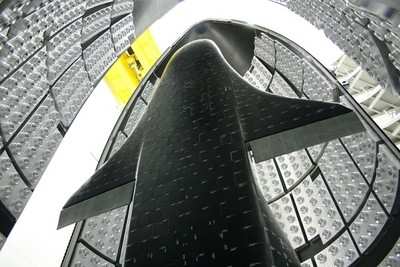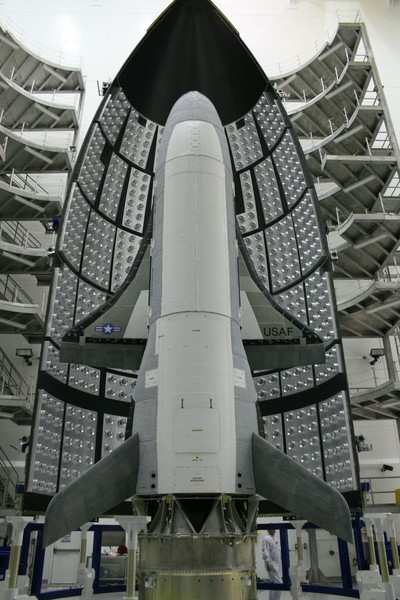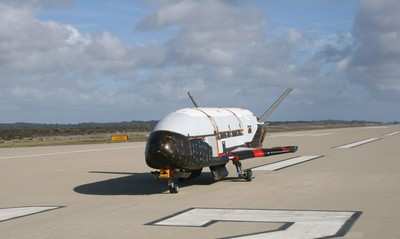Tue, May 25, 2010
Pentagon Denies That The Spacecraft Is A Spy Satellite Test
Bed
The mission of the X-37B Space Plane that launched from Cape
Canaveral last month was shrouded in secrecy. And while the
Pentagon insists that the project seeks "no offensive capabilities"
as far as space-based weapons are concerned, Pentagon leaders have
said that the spacecraft's ultimate mission would be to assist
terrestrial war fighters with any number of missions. Some with
inside knowledge of the program have suggested that the vehicle
could be testing sensors for a new generation of spy satellites,
which the Pentagon has also denied.

Civilian specialists, meanwhile, have said it could fly for up
to 9 months before returning to California for a landing. The
New York Times reports that a group of amateur sky watchers has
tracked X-37B as it orbits the earth. One person in Toronto said
the spacecraft was passing over the same area once every four days.
Ted Molczan said that is a fairly normal pattern for U.S.
reconnaissance satellites.
On a clear night, the X-37B could be visible to the naked eye in
some areas, appearing like a bright star moving across the sky. The
amateur astronomers say they have tracked the ship from as far as
40 degrees north latitude to 40 degrees south latitude. That orbit
would take it over some of the world's most troubled regions, such
as Iraq, Iran, Pakistan, Afghanistan, and North Korea. It appears
to be in an orbit at about 255 miles in altitude, circling the
earth every 90 minutes, much like the shuttle.

The spacecraft, which resembles the shuttle but is about a
quarter of its size with a 14 foot wingspan, was boosted into orbit
on an Atlas 5 rocket with no real explanation of its mission. A
Harvard astronomer who tracks launches and space activity said the
secrecy included sending the rocket's upper stage into an
undisclosed orbit around the sun, the first time the U.S.
Government has done so.

Brian Weedon of the Secure World Foundation said the X-37B could
prove to be a critical asset for rapid reconnaissance missions,
based on the ability of crews to quickly change its payload and
launch it into space. But the former Air Force officer questioned
the need for all the secrecy. He told the paper that if the
spacecraft could be located by a "bunch of amateurs," then it's
likely our enemies could find it as well.
More News
Terminal Radar Service Area Airspace surrounding designated airports wherein ATC provides radar vectoring, sequencing, and separation on a full-time basis for all IFR and participa>[...]
Aero Linx: Utah Back Country Pilots Association (UBCP) Through the sharing experiences, the UBCP has built upon a foundation of safe operating practices in some of the most challen>[...]
From 2010 (YouTube Edition): Imagine... Be The Change... Inspire FROM 2010: One of the more unusual phone calls I have ever received occurred a few years ago... from Anousheh Ansar>[...]
(Pilot) Felt A Shudder And Heard The Engine Sounding Differently, Followed By The Engine Chip Detector Light On April 14, 2025, about 1800 Pacific daylight time, a Bell 206B, N1667>[...]
Also: AMA Names Tyler Dobbs, More Falcon 9 Ops, Firefly Launch Unsuccessful, Autonomous F-16s The Air Force has begun ground testing a future uncrewed jet design in a milestone tow>[...]
 ANN's Daily Aero-Term (05.07.25): Terminal Radar Service Area
ANN's Daily Aero-Term (05.07.25): Terminal Radar Service Area ANN's Daily Aero-Linx (05.07.25)
ANN's Daily Aero-Linx (05.07.25) Classic Aero-TV: Anousheh Ansari -- The Woman Behind The Prize
Classic Aero-TV: Anousheh Ansari -- The Woman Behind The Prize NTSB Prelim: Bell 206B
NTSB Prelim: Bell 206B Airborne-NextGen 05.06.25: AF Uncrewed Fighters, Drones v Planes, Joby Crew Test
Airborne-NextGen 05.06.25: AF Uncrewed Fighters, Drones v Planes, Joby Crew Test





